My friend Chantal sent me and Oliver and lovely, ornately-crafted letter earlier this week, wrapped in an envelope of her own creation. I turned around and turned the envelope into a book and mailed it back to her. It wasn’t a Big Important Project, it was an end of the day “I’ve had too much coffee and have too much unused creativity” project. I loved it.
I read someone a few weeks ago reflecting on their work, and they mentioned taking maximum advantage of the “golden hour.” In photography and film this is the time, around twilight, when you can take photos like this (Boston, MA, 6:35 p.m., April 6, 2019):
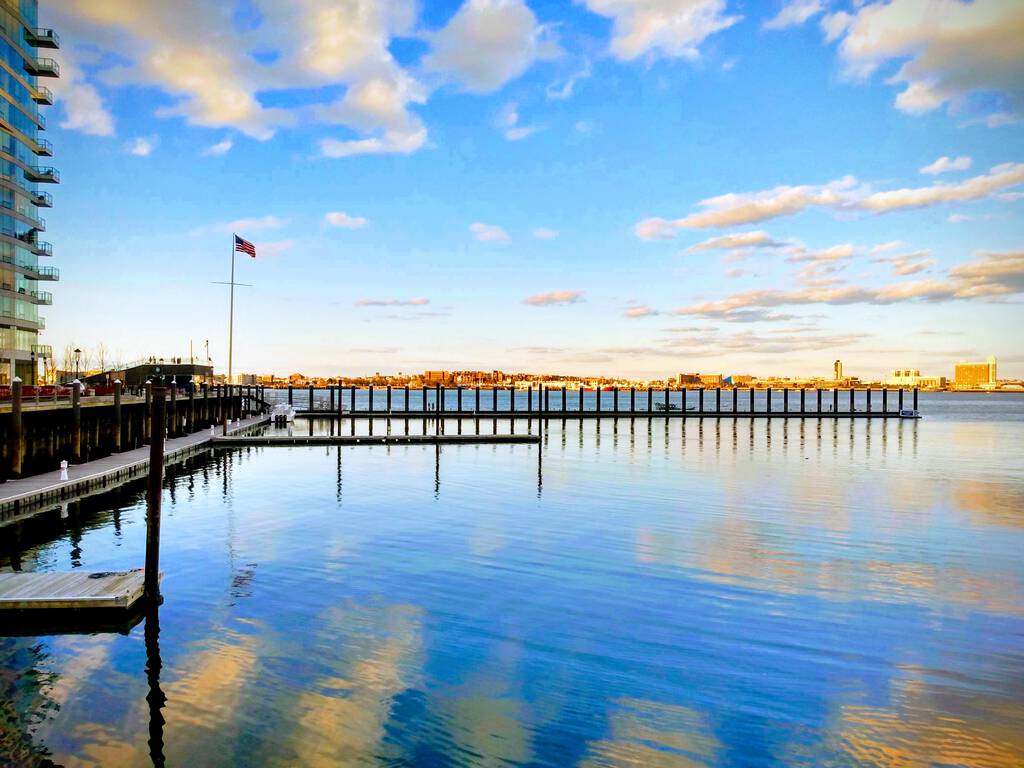
In work, and creativity, though, the golden hour doesn’t need to align with the sun: it can be any time of the day when conditions are ripe for maximum creativity.
Upon finding this hour–I’ve a sneaking suspicion that for me it’s the first hour I’m in the shop every morning–and then using it for something other than catching up on email, prioritizing my ticket queue, and generally entering the QEW of frenetic work life seems key to establishing a healthy creative practice.
So that’s what I’m going to do, for the next while.
Every morning when I arrive at the shop, I’m going to leave the computer off and make a book.
Not a Big Important Book, but an improvisational see-where-the-wind-blows-me book. Like the one I made for Chantal yesterday. I suspect some will be ugly. Some won’t work. Some will be frustrating. And some will be awesome.
Here’s today’s:
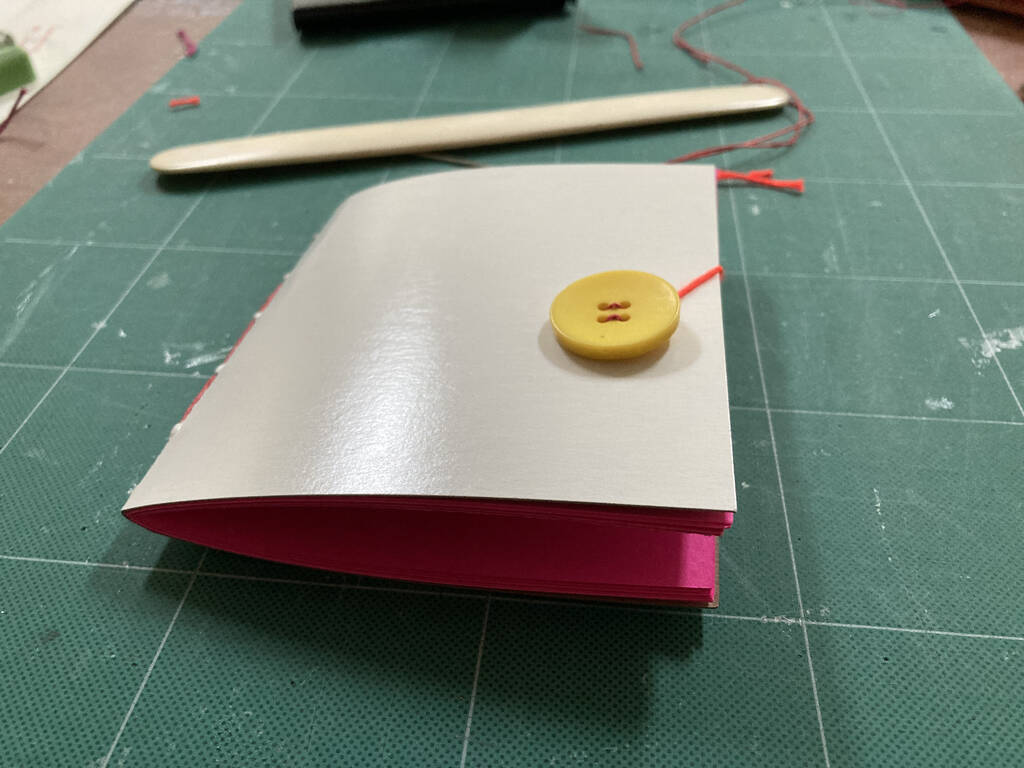
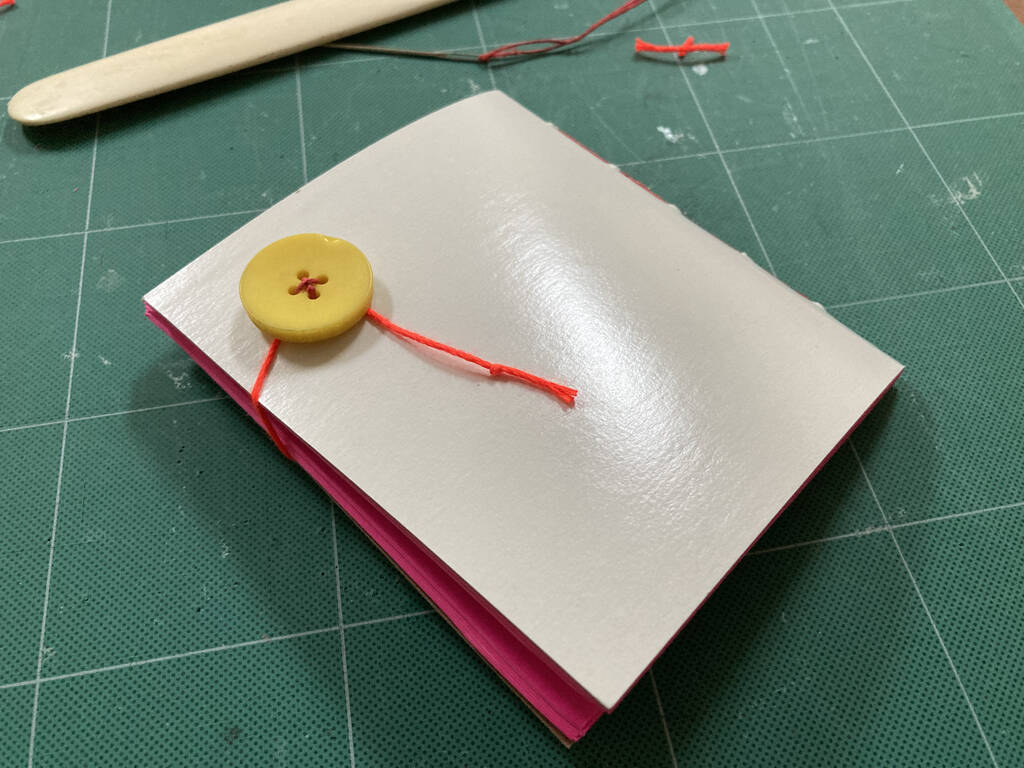
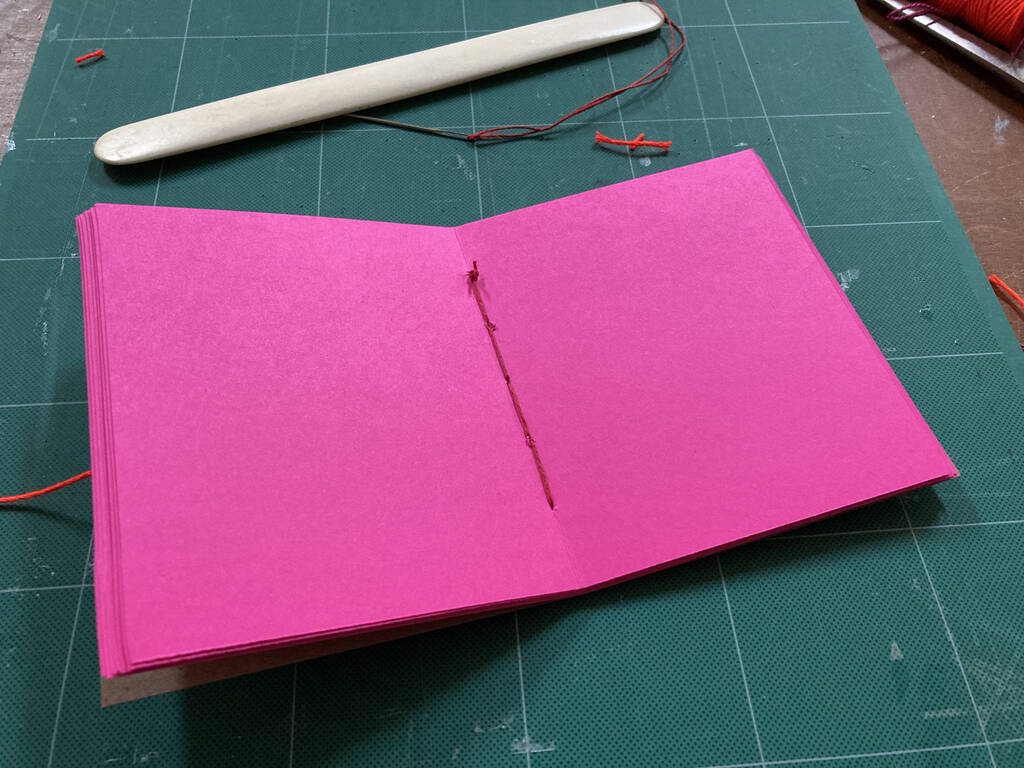
The cover is cut out of a cardboard envelope I received in the mail; the inside papers are pink card stock (which, really, was too heavy for this task, but I love the colour); the cord for the binding is Michael’s hemp beading cord; the twine for the button enclosure is baker’s twine from The Bookmark; the yellow buttons are from the shop button jar. The stitch is a simple pamphlet stitch, the sewing of which was so breezily satisfying after the rigours of the coptic stitch experiments of earlier in the year (here, here).
That time 15 years ago when Dr. Chris Lantz removed the “most challenging foreign ear body ever” from my ear. He has yet to redeem any of his three wishes.
Kalinko distributes Burmese-crafted objects around the world from their base in Yangon. They posted today on their blog about the situation on the ground there:
We’ve had team members having to hide behind bins from gunfire as they try and make it home from protesting. We’ve had makers messaging us in total panic not knowing what to do next or where to hide. We’ve had friends separated from their children overnight by military blockades cracking down on entire areas of Yangon. The internet is cut every night, and the electricity is worse than ever, so people are literally in the dark about what’s going on. Our colleagues are having to hide their toddlers in the bathroom in the evening to try and stifle their shouts of excitement while police are passing their doors. They think the gunfire is fireworks and can’t understand why they can’t go and watch.
There’s a section of their website devoted to profiling everyday people in Myanmar that serves as a powerful reminder of who’s being affected by the coup d’état there.
I sought outfit advice from my brother Mike this morning—he has stronger connections to the real world, and tells the truth, both useful qualities.
He branded it “smart casual.”
Which is a huge step up from the, say, “lethargic distracted” or “frugal deluded” style that might describe my stock in trade otherwise.
Having brothers is great, you know.
Photo by Oliver.

My office mate, and the closest thing I have to a spiritual advisor, Archdeacon John Clarke turns 60 on March 10, 2021, and all he’s asked for is healthy mothers and children in Rwanda, Burundi, Mozambique and Tanzania, asking well wishers to make a donation to The Primate’s World Relief and Development Fund:
Your gift helps ensure the gains made in maternal and newborn health, food security and nutrition will be sustained in Rwanda, Burundi, Mozambique and Tanzania, while these partners work to supply vulnerable communities with PPE (personal protective equipment), information and facilities for handwashing and proper hygiene, and science-based information about prevention and treatment of COVID-19.
You can donate online and gifts are matched 6:1 by Global Affairs Canada.
Lucy Dacus’s Night Shift has been on repeat in my house, my car, and my head for months: while I lack the vocabulary to describe its wonderments, suffice to say that it’s three or four songs packed into one. I love it.
Dacus released Thumbs to Bandcamp today, and it promises similar delights.
In his New Yorker piece on Mike Nichols, Louis Menaud writes:
Nichols later said that he never had a friend until he went to the University of Chicago. He entered in the fall of 1949, when he was seventeen. Nichols was well read, but academically indifferent, professionally undirected, and highly defended. He had nothing to back up his sense of superiority, which is not a good place to be.
This prompted me to think about the notion of being defended versus being undefended, about which I’d use to describe myself, and about whether one is a healthier state than the other.
What do you think?
Beau Miles walked 88 km in 29 hours, from his home in the countryside to a workshop he was presenting in the city. The topic of the workshop: “I chose to walk to work, and this is why.”
He is such a compelling filmmaker and storyteller. What emerges from this film, among other things, is the value of experiencing the same-old same-old in unfamiliar ways so as to see it anew all over again, a helpful ethos during a time when few of us wander more than a few blocks from home.
Don Jardine has been posting up a storm on his Our Island Climate site of late, including an item today about a 1963 lightning strike on Trinity United Church, our neighbour just down Prince Street.
The full story from the September 3, 1963 edition of The Guardian, written by George Condon:
Trinity Church Damaged By Lightning Saturday
Lightning struck Trinity United Church in Charlottetown with the force of an explosion at the height of a storm Saturday and left damage in its wake affecting the entire city.
Trinity itself suffered damage which will run into several hundreds of dollars while neighbouring homes were bombarded by flying brick and pierced by lightning.
Cars in the street were battered while power lines and transformers were burnt to a crisp, causing power failure through most of the city and surrounding districts.
The fury of the lightning was so great persons in most parts of the city, some a half-mile or more away, though[t] the bolt had struck in their immediate vicinity.
The storm began without great fury. It was not until approximately 3:30 p.m. Saturday that it struck with all its force. The sudden crash of thunder was heard for miles while the flash of lightning ran from Southport to the western section of the city. Almost an inch of rain drenched the area at the same time.
DEBRIS SCATTERED
The lightning bolt which struck the church hit with such force that brick-chips from the chimney at the centre of the east wall were found as far away as Grafton Street. The chimney itself disintegrated while lightning tore through the building and out the other side.
The Henry Wooldridge residence, next door at 203 Sydney Street was pelted by falling brick and sustained three holes in the roof and broken windows as a result. The lightning passed right through the house shattering a salt shaker held by Mrs. Wooldridge.
Damage to the Church included the destruction of the rear chimney and nearby brickwork, smashed wall boards and shingles, a rafter split tom the peak of the roof to the eve, loosened bricks and stones on the walls, and curling of the lead flashings at the inside ridge of the roof.
Damage to the church’s electrical system is still undetermined but it is known that many fixtures were shattered, wires were burnt and fuses blown. There were no services in the Church on Sunday.
Sidney Street resembled a war-time scene with great chunks of rubble and broken glass lying about.
M[r]s. Henry Wooldridge, standing over the stove in her kitchen next door, thought there had been an atomic blast. “The windows started breaking and the lightning came right in the back door and out the front,” she said.
As the lightning passed through her kitchen it struck the salt shaker in her hand, scattering the fragments in all directions and stunning her for a second.
LUCKY TO BE ALIVE
“It seemed to come in through the back door and over to the stove. The whole stove was sort of blue and a big flash came down from the light socket. We are lucky to be alive,” she said.
Damage to the Wooldridge home included broken windows, holes in the door, loss of power, including the destruction of the electric motor in their stove, and piles of rubble in the yard.
A hugh slab of concrete missed the house by inches and crushed a wooden tool box Mr. Wooldridge had in the yard.
Sarah VanIderstine, 83, who lives across the street at 200 Sidney, left her chair for only a moment, but when she returned there was broken glass all over the floor and a brick was laying on the chair.
CARS DAMAGED
A Volkswagen car belonging to Roger MacLaren, 205 Sidney Street, had the roof pushed in and the rear window of broken by falling brick. Fred Roberts lost the rear window of his car. A New Brunswick car and at least one other vehicle also received damage.
A gaping hole appeared in the roof of 205 Sydney St. where a bolt of lightning passed through.
Power was disrupted for hours as wires in the immediate vicinity were down and a transformer in the Federal Building was damaged. Power company linemen responded to over a hundred calls in and around the city.
Lightning was seen to be dancing along wires, the top of the new Confederation Memorial structure, and Woolworth’s in the city, and as far away as the Southport Country Club.
Residents saw the lightning which struck the church signalled the end of the storm here.
The story was accompanied by this scene of Sydney Street:
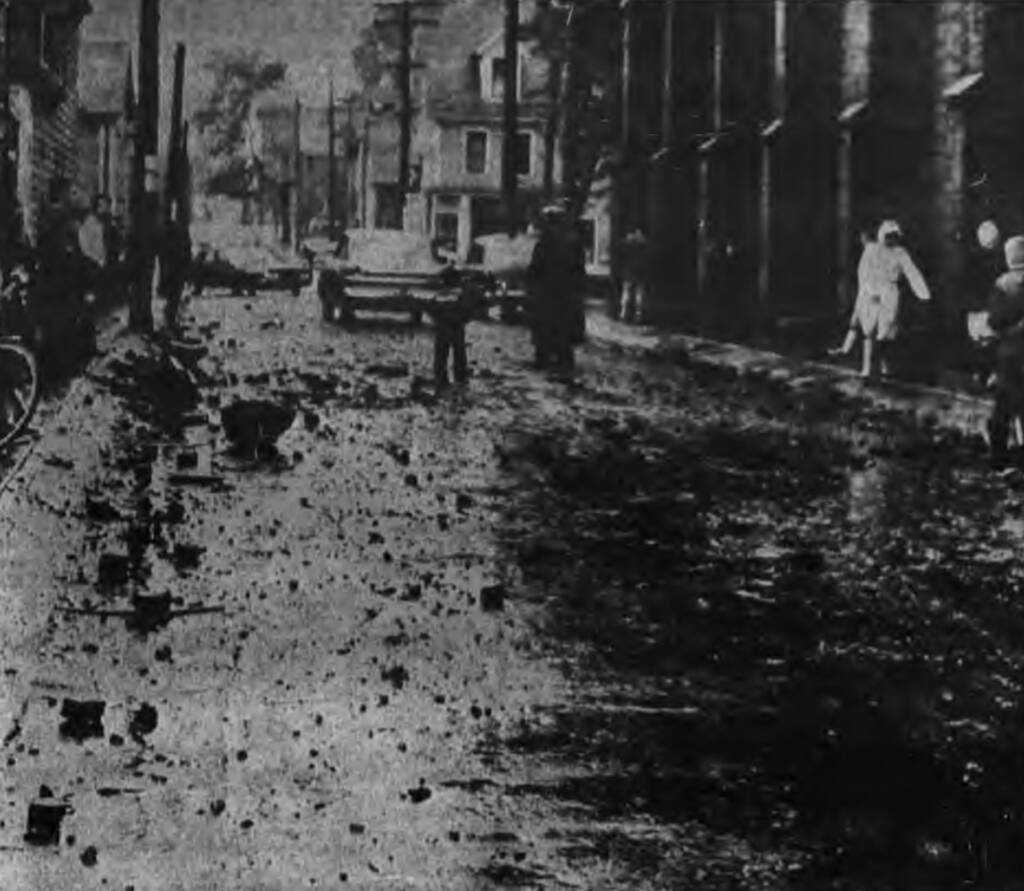

 I am
I am